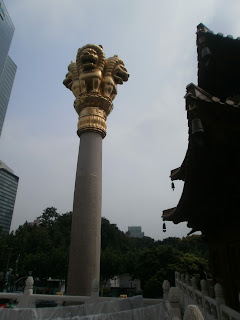In Chandran's house, olappadakkam bursts with a metallic sound always. They use an aluminium pot to create this sound. Crakers after igniting are thrown into this pot that bursts with a different noise. We really did not enjoy the sound however.
Whenever our father was home , he buys crackers a few days before the big day. All fireworks for the eve of the Vishu will be stocked well in advance. On one such ocassion faher bought a plastic bag with a lot of things filled in it.
Out of curiosity we asked him what they were. He simply replied it was dry chillies. We have not believed it, but never tried to dig deep into finding the truth. For hardly two hundred rupees, it was possible to creat a gala of fire works those days. Whatever father bought on that day may not have costed even hundred rupees.
In the morning of the Vishu day, our forecourt will be filled with the remnants of crackers - some fully torn apart , some lying without serving their purpose.These left outs were swept to a corner and burnt along with dry leaves. It was very pleasing to watch bursting crackers in the fire that was lit. That brought curtains to a glorious event associated with Vishu.
For a change, our 'bosom friend' Nanu takes his lunch from his home this day. At the end of all sound and light for over a fortnight, it is feast time. We enjoyed every moment of a thrilling Vishu in the company of Nanu. Narayananakutty who is famously known as Nanu is our cousine and neighbour. On school days Nanu eats lunch from our home.
 The kitty of crackers invariably consisted of busrting ones and sparklers . It was not only the olappadakkam that made noise. There were some powerful bombs too. Though we were so scared to use them, somehow we managed to lit them. On one such occassion, an attempt to set a bomb on fire landed in a near miss.
The kitty of crackers invariably consisted of busrting ones and sparklers . It was not only the olappadakkam that made noise. There were some powerful bombs too. Though we were so scared to use them, somehow we managed to lit them. On one such occassion, an attempt to set a bomb on fire landed in a near miss.
 The kitty of crackers invariably consisted of busrting ones and sparklers . It was not only the olappadakkam that made noise. There were some powerful bombs too. Though we were so scared to use them, somehow we managed to lit them. On one such occassion, an attempt to set a bomb on fire landed in a near miss.
The kitty of crackers invariably consisted of busrting ones and sparklers . It was not only the olappadakkam that made noise. There were some powerful bombs too. Though we were so scared to use them, somehow we managed to lit them. On one such occassion, an attempt to set a bomb on fire landed in a near miss.
The bomb was lit and we ran away. But realising that fire has not started in the bomb we quikly approached the bomb to re-ignite. The bomb busted with a deafening noice as we were about to bring the source of fire near it. The jolt we received on that day is still fresh in mind. Whenever I remember Nanu, essentially I must remember this incident. We however escaped unscathed on that day.
The "Vishu Kanji" is prepared by Nanu's mother. Nanu's mother is our maternal aunt. The tastiest Vishu Kanji I ever had was prepared by this aunt. Vishu Kanji is a customary gruel, prepared on the Vishu day using rice, coconut milk, grated coconut and jeera. On this Vishu day too, we prepared Vishu Kanji. Probably it also did have all the ingadients as mentioned above, but it could never match with the taste of those preparations. May the taste of everything that was enjoyed in the innocent childhood linger on till the last breath.
Let us celebrate all festivals, be it Vishu, Onam, Christmas, Easter or Ramzan, in its tradinational ways. Let the younger generations know the true spirit of our civilizations and what values they represent. Above all, the younger ones too need something to write about when they have nothing else to do!!
Let us celebrate all festivals, be it Vishu, Onam, Christmas, Easter or Ramzan, in its tradinational ways. Let the younger generations know the true spirit of our civilizations and what values they represent. Above all, the younger ones too need something to write about when they have nothing else to do!!

























